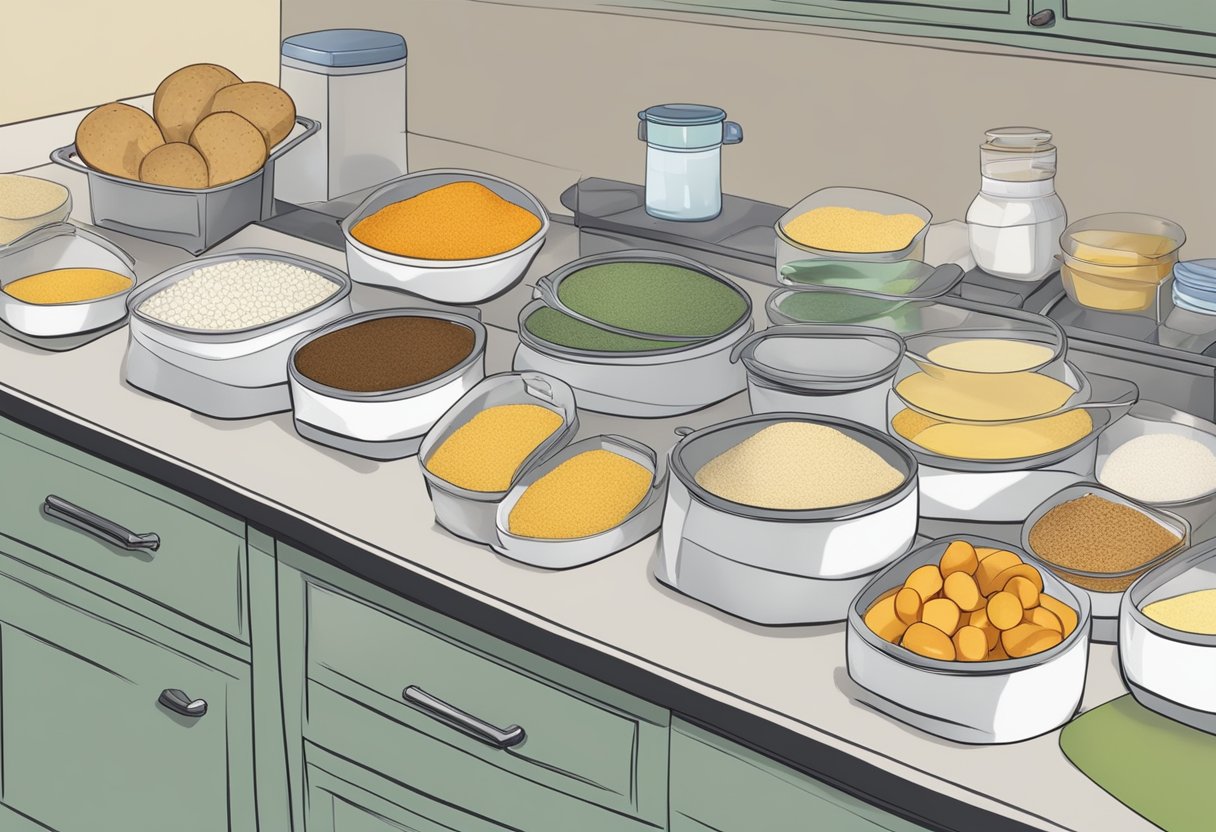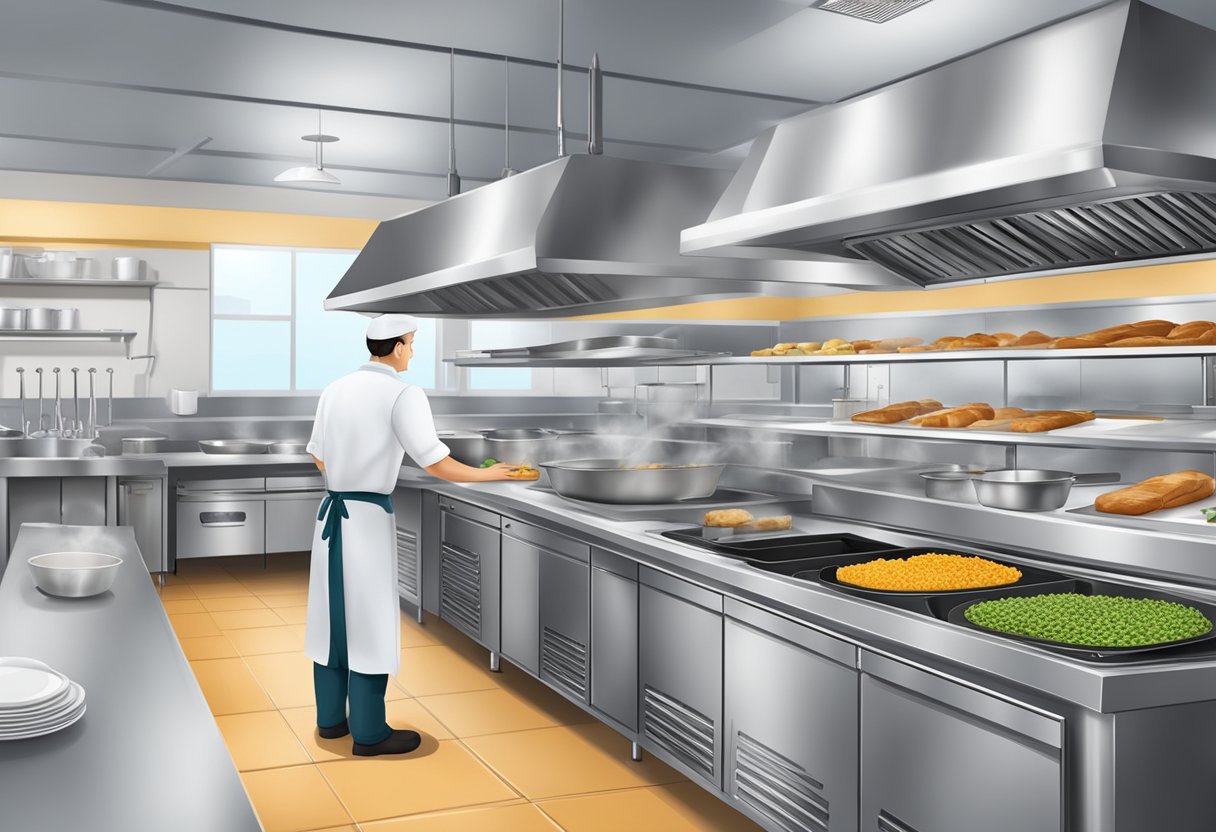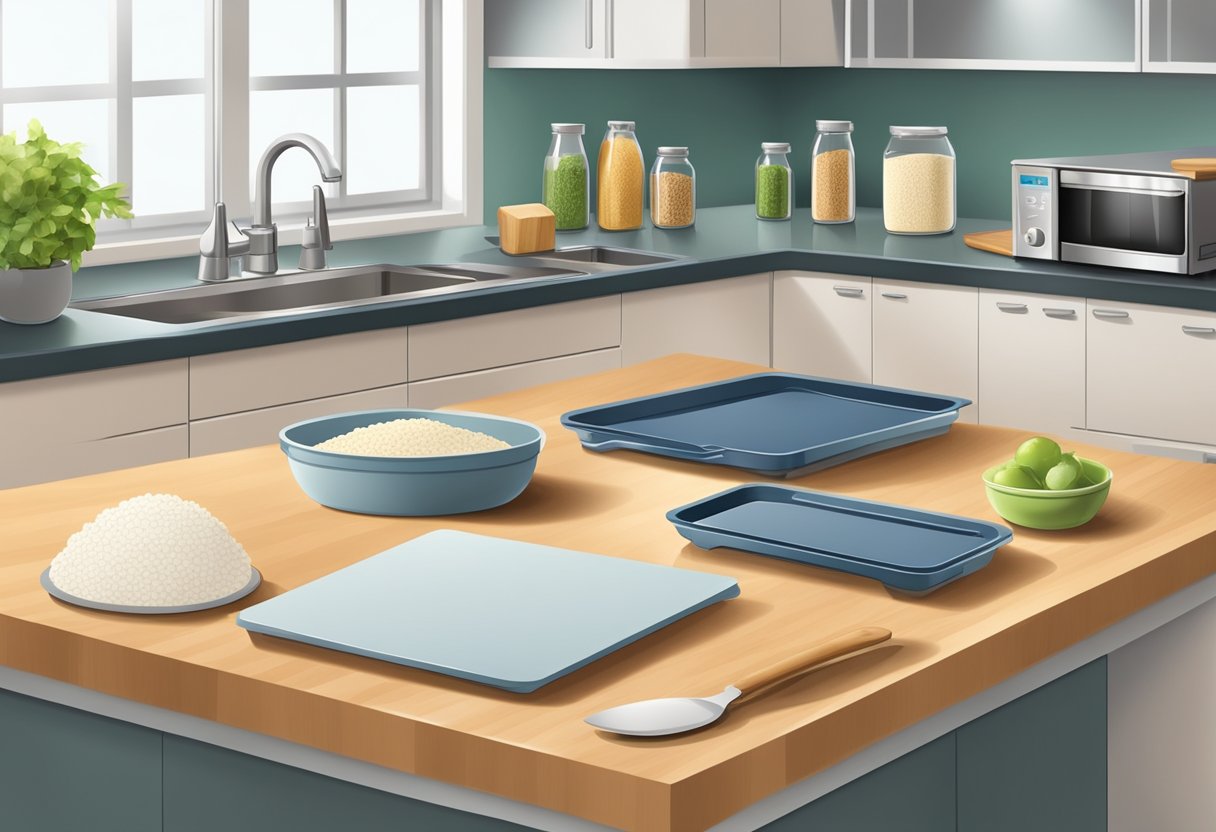Cross-contamination is a critical concern for individuals with celiac disease or gluten sensitivities, where even the smallest trace of gluten can trigger significant health problems. Gluten, a group of proteins found in wheat, rye, and barley, is often stealthily pervasive, lurking in many foods and surfaces, from kitchen toasters to manufacturing conveyor belts. For those determined to adhere to a strict gluten-free Mediterranean diet, understanding and managing cross-contamination is not just beneficial, it’s a necessity for maintaining health and preventing the onset of symptoms.

Maintaining a gluten-free diet requires a multifaceted approach that goes beyond choosing gluten-free ingredients. The risk of inadvertent gluten exposure through cross-contamination can occur at any point during food production, preparation, and consumption. Individuals must be diligent in their strategies for maintaining a gluten-free environment, whether it’s in their own kitchen or while dining out. Educating friends, family, and food service staff about the requirements of a gluten-free diet ensures supportive cooperation and reduces risks. For consumers, understanding food labeling and regulatory standards is also critical for making safe choices.
Key Takeaways
- Cross-contamination is a concern for anyone with celiac disease or gluten-related disorders.
- A stringent approach is required to prevent gluten exposure in a gluten-free diet.
- Education and awareness of food handling practices are essential to avoid gluten cross-contamination.
Table of Contents
Understanding Gluten and Celiac Disease
To effectively manage a gluten-free diet, one must grasp the fundamentals of gluten and its impact on individuals with celiac disease. Understanding what constitutes gluten, the nature of celiac disease, and the typical symptoms that may occur with gluten exposure is crucial, especially within the context of a gluten-free Mediterranean diet.
What Is Gluten
Gluten is a group of proteins found in certain grains, such as wheat, barley, and rye. It acts as a binder that holds food together, giving it shape and elasticity. In a Mediterranean diet, a person with celiac disease must avoid traditional staples that contain gluten, like bread and pasta, and focus instead on inherently gluten-free foods like fruits, vegetables, legumes, nuts, seeds, fish, and lean meats.
Overview of Celiac Disease
Celiac disease is an autoimmune disorder where the ingestion of gluten leads to damage in the small intestine. When a person with celiac disease consumes gluten, their immune system responds by attacking the lining of the small intestine. This damage hinders the absorption of nutrients and can lead to various health complications. To prevent this damage, strict adherence to a gluten-free Mediterranean diet is essential.
Symptoms of Gluten Exposure
Symptoms of gluten exposure in individuals with celiac disease can vary widely but often include gastrointestinal issues such as bloating, diarrhea, and abdominal pain. Other symptoms may include fatigue, skin rashes, and anemia. Long-term complications can arise from continual exposure to gluten, making it important for those with celiac disease to identify and manage their symptoms diligently within their gluten-free Mediterranean dietary choices.
Recognizing Sources of Cross-Contamination
Ensuring a gluten-free diet remains uncontaminated is vital for individuals with celiac disease or gluten sensitivity. The risk of cross-contamination is ever-present, but it can be managed by identifying where it most commonly occurs.
Gluten-Containing Foods and Ingredients
Cross-contamination can happen when gluten-free foods come into contact with gluten-containing foods. The Mediterranean diet, rich in fruits, vegetables, beans, nuts, seeds, and gluten-free grains such as quinoa and rice, should be kept separate from gluten-containing grains like wheat, barley, and rye. Gluten can be found in a variety of Mediterranean staples – from couscous and bulgur to some types of bread and pasta.
- Avoid: Wheat, barley, rye, and derivatives (e.g., malt, brewer’s yeast).
Common Cross-Contact Points
Kitchen utensils and surfaces are frequent sites for cross-contact. To reduce risk:
- Always designate and consistently use separate cutting boards, toasters, and pots for gluten-free cooking.
- Clean surfaces thoroughly before preparing gluten-free meals.
- Mark or label containers and utensils as “gluten-free” to avoid mix-ups.
Hidden Sources of Gluten
Gluten can lurk in less obvious places, undermining efforts to maintain a gluten-free Mediterranean diet. This includes processed foods, seasonings, and even some non-food items.
- Check labels on sauces, dressings, and condiments.
- Be wary of “gluten-free” versions of processed food that may still encounter cross-contamination during manufacturing.
- Review ingredients of herbal and nutritional supplements as these can contain hidden gluten.
Preventing Gluten Cross-Contamination at Home
Maintaining a gluten-free diet requires vigilance, especially in a home kitchen where gluten can easily sneak into food through cross-contamination. Below are key measures one should implement to prevent gluten from compromising a gluten-free Mediterranean diet.
Setting Up a Gluten-Free Kitchen
To ensure a truly gluten-free environment, it’s crucial to designate specific areas of the kitchen for gluten-free food preparation. This involves assigning separate storage spaces for gluten-free products, especially grains such as quinoa and rice which are staples of the Mediterranean diet. Ideally, these should be stored above gluten-containing foods to avoid any particles falling onto gluten-free items.
- Designated Areas: Assign shelves for gluten-free products.
- Separate Grains: Store gluten-free grains like quinoa and rice on upper shelves.
Choosing Safe Kitchen Tools and Appliances
Utilizing separate utensils and appliances for gluten-free cooking is essential. Tools like a toaster, knife, and colander should be exclusively used for gluten-free foods to avoid exposure to gluten residues. For instance, investing in a gluten-free toaster helps prevent bread crumbs from gluten-containing products contaminating gluten-free bread.
- Utensils: Use bold and separate sets for gluten-free cooking.
- Toaster: Invest in a dedicated gluten-free toaster.
Proper Cleaning Techniques
Effective cleaning methods are critical in avoiding gluten cross-contamination. Sponges and cleaning cloths should be replaced regularly, and separate ones must be used for gluten-free zones. Moreover, cutting boards, pots and pans, and other surfaces must undergo thorough cleaning with soap and water after each use.
- Sponges: Replace frequently and use designated sponges for gluten-free cleaning.
- Cutting Boards: Clean thoroughly after each use to remove gluten residues.
Contamination can also occur through condiments; therefore, it’s recommended to use squeeze bottles or single-use packets to prevent the mixing of utensils.
- Condiments: Opt for squeeze containers to avoid double-dipping.
Gluten-Free Diet Management
Managing a gluten-free diet effectively involves careful selection of foods and products, along with vigilant monitoring to prevent cross-contamination. It is not just about avoiding gluten; it is about embracing a lifestyle that ensures one’s health and well-being, especially within the context of a gluten-free Mediterranean diet.
Identifying Naturally Gluten-Free Foods
The cornerstone of maintaining a gluten-free diet is the knowledge of naturally gluten-free foods. These include fruits, vegetables, legumes, nuts, seeds, and most dairy products. Grains that are naturally devoid of gluten consist of rice, quinoa, amaranth, and corn. Staples of the Mediterranean diet such as olive oil, fish, and lean meats are also inherently gluten-free and form the heart of dietary adherence.
Navigating Gluten-Free Products
When exploring gluten-free products, it is crucial to look for those that are certified gluten-free. This certification ensures that products have been tested and contain less than 20 parts per million (ppm) of gluten. People on a gluten-free diet should read labels diligently, as products can be cross-contaminated with gluten during manufacturing. A variety of gluten-free alternatives to classic Mediterranean staples such as pasta and bread are available but always require verification of their gluten-free status.
Checklist for Gluten-Free Diet Adherence
Daily Diet Checklist:
- Choose Whole Foods: Incorporate a variety of fresh produce, lean proteins, and gluten-free grains.
- Read Labels: Products labeled as “gluten-free” or “certified gluten-free” are preferable.
- Prevent Cross-Contact: Use separate cooking utensils and appliances for gluten-free foods to minimize the risk of exposure.
- Stay Informed: Keep updated on current gluten-free diet guidelines and research.
- Plan Ahead: Prepare a weekly menu that includes diverse, naturally gluten-free Mediterranean dishes.
- Stock Up: Ensure the pantry is filled with gluten-free staples like gluten-free pasta made from rice or legumes.
By strictly following these guidelines, individuals on a gluten-free diet can successfully manage their dietary restrictions while enjoying the rich, flavorful elements of a Mediterranean diet.
Guidelines for Eating Out

When one follows a gluten-free Mediterranean diet, navigating dining out requires diligence and communication. It’s essential for individuals to identify establishments that are accommodating and to be proactive about avoiding cross-contact with gluten.
Choosing the Right Restaurants
Research is vital for anyone with celiac disease or gluten sensitivity. They should look for restaurants with a clear commitment to gluten-free options, such as those that offer a separate gluten-free menu or have certification from a gluten-free organization. Restaurants that are familiar with the Mediterranean diet may also be more adept at identifying hidden sources of gluten in dishes such as soups, sauces, or dressings that often accompany Mediterranean meals.
Managing Cross-Contamination Risks in Public Eating Spaces
Buffets pose a particular risk for cross-contact. Individuals should be wary of gluten-containing items placed adjacent to gluten-free foods or shared serving utensils that can lead to contamination. They might opt for restaurants that don’t use shared serving areas or prioritize those that have clear labeling and dedicated sections and utensils for gluten-free options.
Communicating with Food Service Staff
Effective communication with chefs and servers is critical. Patrons should convey their dietary restrictions clearly and inquire about food preparation practices. They could ask questions such as, “Do you use a separate toaster for gluten-free bread?” and discuss the risks of cross-contamination from shared cooking surfaces. This direct approach can help the staff to ensure that the meal served is truly gluten-free.
Educating Friends and Family

When maintaining a gluten-free Mediterranean diet, it’s essential that friends and family understand how to support this dietary need to ensure the individual’s quality of life is not compromised.
Informing Household Members
Household members play a crucial role in maintaining a safe gluten-free environment. They must understand the implications of cross-contact and the importance of strict adherence to dietary restrictions, especially within a shared kitchen. To educate household members, consider these steps:
- Create a dedicated gluten-free zone: Allocate specific areas for gluten-free food preparation to minimize the risk of cross-contact.
- Label all gluten-free items: Clearly mark gluten-free food and utensils. For instance, having a separate toaster for gluten-free items is recommended.
- Conduct a kitchen orientation: Show where gluten-free items are stored and demonstrate proper cleaning techniques for shared surfaces and appliances.
- Share educational resources: Provide literature or online material on the importance of a gluten-free diet for individuals with celiac disease or gluten sensitivity, illustrating how even small amounts of gluten can cause harm.
Hosting Gluten-Free Guests
When someone with a gluten-free Mediterranean diet visits, their hosts can take specific actions to prevent cross-contamination. It is possible to provide safe and delicious meals without compromising their dietary needs:
- Prioritize meal planning: Discuss menu options with the guest in advance to ensure the meal is both gluten-free and aligns with Mediterranean dietary choices.
- Avoid gluten-containing ingredients: Ingredients such as couscous and regular pasta should be substituted with gluten-free alternatives like quinoa or rice.
- Utensils and Cookware: Use glass, stainless steel, or hard plastic cookware, and avoid utensils made of porous materials like wood, which can harbor gluten residues.
- Cook gluten-free meals first: This reduces the risk of accidental cross-contamination from gluten-eaters’ meals.
By taking these measures, hosts show respect and consideration, reducing potential feelings of anger or exclusion among guests who follow a strict gluten-free regimen. This attention to detail ultimately safeguards the guest’s health and enables them to enjoy a shared meal with confidence.
Strategies for Safe Food Processing and Manufacturing
In the gluten-free products market, maintaining the integrity of food items during processing and manufacturing is crucial to prevent cross-contamination. Food manufacturers must employ stringent protocols to ensure that gluten contamination is minimized.
Avoiding Contamination in Food Production
In manufacturing facilities, dedicated equipment and production lines are fundamental to avoid gluten contamination. Rigorous cleaning processes between production runs can further reduce the risk of cross-contamination. For food manufacturers focusing on a gluten-free Mediterranean diet, it is especially important to scrutinize common ingredients such as grains, pasta, and bread crumbs, ensuring they are authentically gluten-free.
- Segregate storage areas for gluten-containing and gluten-free raw materials.
- Use color-coded tools and containers to differentiate between gluten-free and regular production items.
- Employ air filtration systems to prevent airborne flour from contaminating gluten-free products.
Best Practices for Food Manufacturers
Adherence to best practices for food manufacturers is essential for safe food production, especially when processing Mediterranean diet staples like vegetables, legumes, and seafood, which are naturally gluten-free.
- Implement strict personal hygiene protocols. Personnel must wash hands properly and wear protective clothing.
- Conduct regular staff training about the importance of preventing gluten contamination.
- Establish a testing regimen for both raw materials and final products to ensure gluten levels remain below accepted thresholds for gluten-free labeling.
By consistently applying these strategies, manufacturers can contribute significantly to a safe gluten-free food supply.
Regulatory Standards and Food Labeling
Navigating the complexities of maintaining a strict gluten-free diet, especially along the lines of a Mediterranean dietary pattern, requires understanding the regulatory landscape. The accuracy of food labels is paramount as consumers must be able to trust that “gluten-free” claims align with their health needs.
Understanding FDA Guidelines for Gluten-Free Labeling
The FDA sets specific criteria for what constitutes a “gluten-free” product. To be labeled gluten-free, a food item must contain less than 20 parts per million (ppm) of gluten. This standard ensures that individuals with celiac disease or gluten intolerance can consume products without harm, aligning their diets closely with gluten-free Mediterranean standards. Additionally, the FDA regulations cover all packaged foods, including dietary supplements, that fall under their jurisdiction. Foods naturally void of gluten, like fruits and vegetables typical to the Mediterranean diet, may also be labeled as gluten-free (Gluten and Food Labeling | FDA).
Interpreting Labels on Gluten-Free Products
When consumers encounter a gluten-free label on a product, it should signal that the food manufacturer has complied with FDA regulations. Consumers should look for clear labeling and certification marks that indicate a product has been tested and meets gluten-free standards. Certified gluten-free logos can provide additional reassurance. Yet, not all gluten-free foods get certification, making it essential to read labels carefully. For someone adhering to a gluten-free Mediterranean diet, inspecting labels for hidden gluten in processed foods like soups, sauces, or flavorings is critical. It’s also wise to be cautious of potential cross-contamination that could occur if foods are processed or prepared in a facility that also handles gluten-containing items.
Frequently Asked Questions
Navigating a gluten-free lifestyle, especially within the constraints of a Mediterranean diet, requires attention to detail to avoid cross-contamination. These FAQs address the most common concerns individuals face when maintaining a strictly gluten-free diet.
How can you avoid cross contamination with gluten at home?
Individuals should have designated gluten-free areas and appliances, especially when dealing with shared spaces. It’s imperative to have separate toasters for gluten-free items, as recommended by experts at BeyondCeliac.org.
What are the common symptoms of gluten cross contamination for those with Celiac disease?
Symptoms can range from mild to severe and may include abdominal pain, bloating, diarrhea, and fatigue. The extent of symptoms varies, but internal damage to the small intestine occurs regardless of their severity.
Can gluten cross contamination occur through kissing and what precautions are necessary?
Yes, gluten can be transferred through kissing. To prevent cross-contamination, both parties should ensure they have not consumed gluten-containing products or have thoroughly cleaned their mouths beforehand.
What steps can be taken to prevent gluten cross contamination in a shared kitchen, such as using an oven?
To minimize risk in shared kitchens, individuals should use separate utensils and cookware or line baking sheets and oven racks with foil or parchment paper to create a barrier between gluten-containing foods and gluten-free items.
What measures do restaurants need to put in place to ensure meals are safe for customers with gluten intolerance?
Restaurants should train staff thoroughly about gluten cross contamination and establish specific protocols like using separate prep areas, utensils, and cooking equipment for gluten-free meals. It’s crucial for eateries to understand the care that must be taken to keep food free of gluten.
How can someone with gluten sensitivity recover from accidental cross contamination?
After accidental gluten ingestion, it’s important to drink plenty of water, rest, and return to a strict gluten-free diet to allow the body to heal. Over-the-counter aids may alleviate symptoms, but consulting a healthcare provider is advisable for tailored advice.



